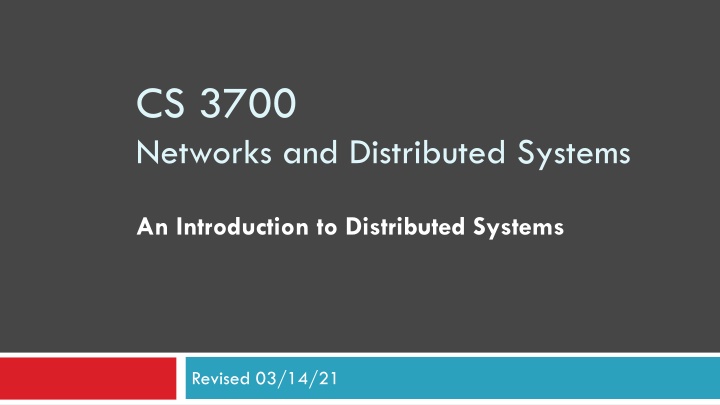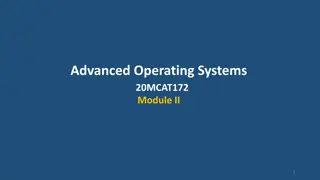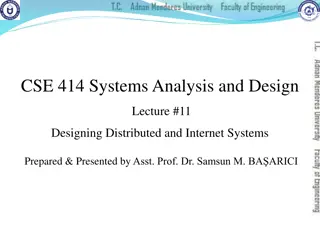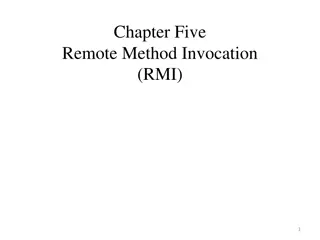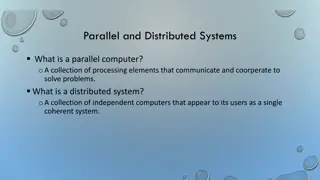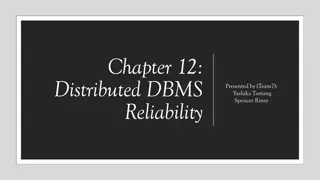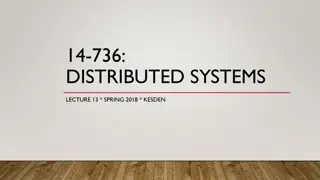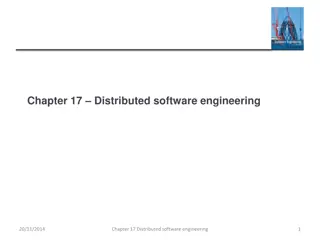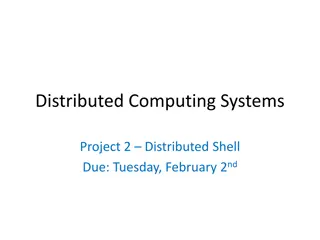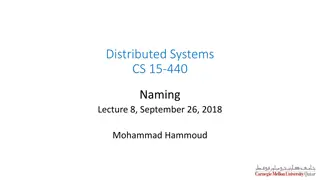Introduction to Distributed Systems
In this introduction to distributed systems, learn about the application layer, challenges such as scalability and security, definitions, and a brief history with examples like Sabre and American Airlines. Explore the concept of distributed systems' development and early applications.
Download Presentation

Please find below an Image/Link to download the presentation.
The content on the website is provided AS IS for your information and personal use only. It may not be sold, licensed, or shared on other websites without obtaining consent from the author.If you encounter any issues during the download, it is possible that the publisher has removed the file from their server.
You are allowed to download the files provided on this website for personal or commercial use, subject to the condition that they are used lawfully. All files are the property of their respective owners.
The content on the website is provided AS IS for your information and personal use only. It may not be sold, licensed, or shared on other websites without obtaining consent from the author.
E N D
Presentation Transcript
CS 3700 Networks and Distributed Systems An Introduction to Distributed Systems Revised 03/14/21
Application Layer 2 Function: Whatever you want Implement your app using the network Application Presentation Session Transport Network Data Link Physical Key challenges: Scalability Fault tolerance Reliability Security Privacy
What are Distributed Systems? 3 From Wikipedia: A distributed system is a software system in which components located on networked computers communicate and coordinate their actions by passing messages. Essentially, multiple computers working together Computers are connected by a network Exchange information (messages) System has a common goal
Definitions 4 No widely-accepted definition, but Distributed systems comprised of hosts or nodes where Each node has its own local memory Hosts connected via a network Originally, requirement was physical distribution Today, distributed systems can be on same host E.g., VMs on a single host, processes on same machine
Outline 5 Brief History of Distributed Systems Examples Fundamental Challenges Design Decisions
History 6 Distributed systems developed in conjunction with networks Early applications: Remote procedure calls (RPC) Remote access (login, telnet) Human-level messaging (email) Bulletin boards (Usenet)
Early Example: Sabre 7 Sabre was the earliest airline Global Distribution System The system that they use at the airports
Sabre 8 American Airlines had a central office with cards for each flight Travel agent calls in, worker would mark seat sold on card 1960 s built a computerized version of the cards Disk (drum) with each memory location representing number of seats sold on a flight Built network connecting various agencies Distributed terminals to agencies Effect: Removed human from the loop
Move Towards Microcomputers 10 In the 1980s, personal computers became popular Moved away from existing mainframes Required development of many distributed systems Email Web DNS Scale of networks grew quickly, Internet came to dominate
Today 11 Growth of pervasive and mobile computing End users connect via a variety of devices, networks More challenging to build systems Popularity of cloud computing Essentially, can purchase computation and connectivity as a commodity Many startups don t own their servers All data stored in and served from the cloud How do we build secure, reliable systems?
Outline 12 Brief History of Distributed Systems Examples Fundamental Challenges Design Decisions
Example 1: DNS 13 Distributed database Maps names to IP addresses, and vice- versa Root Hierarchical structure Divides up administrative tasks Enables clients to efficiently resolve names edu com org Simple client/server architecture Recursive or iterative strategies for traversing the server hierarchy neu.edu mit.edu ccs.neu.edu
Example 2: The Web 14 Web is a widely popular distributed system Has two types of entities: Web browsers: Clients that render web pages Web servers: Machines that send data to clients All communication over HTTP
Example 3: BitTorrent 15 Popular P2P platform for large content distribution All clients equal Collaboratively download data Use custom protocol over HTTP Robust if (most) clients fail (or are removed)
Example 4: Stock Market 16 Large distributed system (NYSE, BATS, etc.) Many players Economic interests not aligned All transactions must be executed in-order E.g., super hot IPO s, a la Facebook Transmission delay is a huge concern Hedge funds will buy up rack space closer to exchange datacenters Can arbitrage millisecond differences in delay
Outline 17 Brief History of Distributed Systems Examples Seven Fundamental Challenges Design Decisions
Challenge 1: Global Knowledge 18 No host has global knowledge Need to use network to exchange state information Network capacity is limited; can t send everything Information may be incorrect, out of date, etc. New information takes time to propagate Other changes may happen in the meantime Key issue: How can you detect and address inconsistencies?
Challenge 2: Time 19 Time cannot be measured perfectly Hosts have different clocks, skew Network can delay/duplicate messages How to determine what happened first? In a game, which player shot first? In a GDS like Sabre, who bought the last seat on the plane? Need to have a more nuanced abstraction to represent time
Challenge 3: Failures 20 A distributed system is one in which the failure of a computer you didn't even know existed can render your own computer unusable. Leslie Lamport Failure is the common case As systems get more complex, failure more likely Must design systems to tolerate failure E.g., in Web systems, what if server fails? Systems need to detect failure, recover
Challenge 4: Scalability 21 Systems tend to grow over time How to handle future users, hosts, networks, etc? E.g., in a multiplayer game, each user needs to send location to all other users O(n2) message complexity Will quickly overwhelm real networks Can reduce frequency of updates (with implications) Or, choose nodes who should update each other
Challenge 5: Concurrency 22 To scale, distributed systems must leverage concurrency E.g. a cluster of replicated web servers E.g. a swarm of downloaders in BitTorrent Often will have concurrent operations on a single object How to ensure object is in consistent state? E.g., bank account: How to ensure I can t overdraw? Solutions fall into many camps: Serialization: Make operations happen in defined order Transactions: Detect conflicts, abort Append-only structures: Deal with conflicts later .
Challenge 6: Security 23 Distributed systems often have many different entities May not be mutually trusting (e.g., stock market) May not be under centralized control (e.g. the Web) Economic incentives for abuse Systems often need to provide Confidentiality (only intended parties can read) Integrity (messages are authentic) Availability (system cannot be brought down)
Challenge 7: Openness 24 Can system be extended/re-implemented? Can anyone develop a new client? Requires specification of system/protocol published Often requires standards body (IETF, etc) to agree Cumbersome process, takes years Many corporations simply publish own APIs (force of market share) IETF works off of RFC (Request For Comment) Anyone can publish, propose new protocol Rough consensus and running code
Outline 25 Brief History of Distributed Systems Examples Seven Fundamental Challenges Five Design Decisions
Distributed System Architectures 26 Two primary architectures: Client-server: System divided into clients (often limited in power, scope, etc) and servers (often more powerful, with more system visibility). Clients send requests to servers. Peer-to-peer: All hosts are equal , or, hosts act as both clients and servers. Peers send requests to each other. More complicated to design, but with potentially higher resilience.
Messaging Interface 27 Messaging is fundamentally asynchronous Client asks network to deliver message Waits for a response What should the programmer see? Synchronous interface: Thread is blocked until a message comes back. Easier to reason about. Asynchronous interface: Control returns immediately, response may come later. Programmer has to remember all outstanding requests. Potentially higher performance.
Transport Protocol 28 At a minimum, system designers have two choices for transport UDP Good: low overhead (no retries or order preservation), fast (no congestion control) Bad: no reliability, may increase network congestion TCP: Good: highly reliable, fair usage of bandwidth Bad: high overhead (handshake), slow (slow start, ACK clocking, retransmissions) However, you can always roll your own protocol on top of UDP Microtransport Protocol (uTP) used by BitTorrent QUIC invented by Google, used in Chrome to speed up HTTP Warning: making your own transport protocol is very difficult
Serialization/Marshalling 29 All hosts must be able to exchange data, thus choosing data formats is crucial On the Web form encoded, URL encoded, XML, JSON, In hard systems MPI, Protocol Buffers, Thrift Considerations Openness: is the format human readable or binary? Proprietary? Efficiency: text is bloated compared to binary, but easy to debug Versioning: can you upgrade your protocol to v2 without breaking v1 clients? Language support: do your formats and types work across multiple languages?
Naming 30 Need to be able to refer to hosts/processes Naming decisions should reflect system organization E.g., with different entities, hierarchal system may be appropriate (entities name their own hosts) Naming must also consider Mobility: hosts may change locations Authenticity: how do hosts prove who they are? Scalability: how many hosts can a naming system support? Convergence: how quickly do new names propagate?
Rest of the Semester 31 Will explore a few distributed system basics Time/clocks Fault tolerance and consensus Security But, most time spent exploring real system Essentially, case studies Will explore Web, BitTorrent, and Tor (maybe) in depth and discuss other related systems along the too Different points in design space, address problems differently
